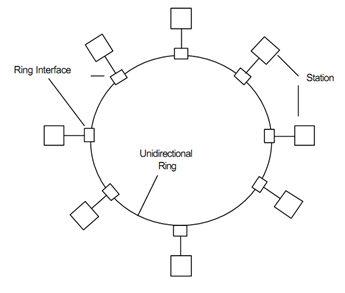IEEE Standard 802.5 (Token Ring)
The IEEE802.5 standard stands for Token Ring LAN. A ring in fact consists of a collection of a ring interfaces associated by point-to-point lines. Each of bits arriving at an interface is copied to a 1-bit buffer and after that copied out onto the ring again. When in the buffer, the bit might be inspected & possibly modified before being discarded. This copying step introduces a 1-bit delay at each interface. In a token ring a special bit pattern, called as the token, circulates around the ring when all stations are idle. While a station wants to transmit a frame, it is needed to seize a token and eliminate it from the ring before transmitting. This action is completed by inverting a single bit in the 3-bytes token, which changes instantly it into the first 3 bytes of a normal data frame. Because there is just one token, only one station might transmit at a given instant, therefore solving the channel access problem the same way as the token bus solves it. A ring and its interfaces are illustrated in figure.

Figure: A Ring Network